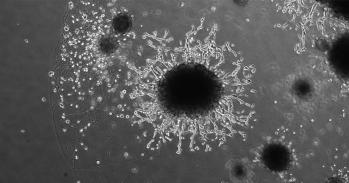
The Cambridge Stem Cell Initiative enters its second phase with the launch of the Laboratory for Regenerative Medicine.
The Cambridge Stem Cell Initiative enters its second phase with the launch of the Laboratory for Regenerative Medicine.
It will be particularly important to learn how stem cells of various types maintain their unique quality of self-renewal, how they regulate production of the more specialised cells that make up most of any tissue or organ, and how they interact with their niche.
Imagine a time still some years into the future. You are among the 1 in 10 people who will experience cellular degeneration at the centre of the eye’s retina as part of their ageing process. Following your diagnosis and selection as a patient, you enter the Treatment Centre for a transplant to your pigmented retina that will arrest the degeneration and preserve your remaining sight. The transplant has been generated by combining a bioengineered fabric (the scaffold) with stem-cell-derived pigmented retina cells (the cargo), and it will take over the function that has been lost by your own degenerating cells.
Although still hypothetical, this scenario is a realistic goal of the Cambridge Stem Cell Initiative. Launched in 2002, the Initiative brings together stem cell scientists, bioengineers and medical researchers to achieve ‘translation’ of basic discoveries to therapeutic applications. The University of Cambridge has invested over £30 million refurbishing and equipping two buildings for stem cell research: its first phase, the Wellcome Trust Centre for Stem Cell Research, was launched in December 2006 and is located in the heart of the University’s Biological Sciences campus in central Cambridge. The Initiative is now entering its second phase with the launch of the Laboratory for Regenerative Medicine (LRM) on the Addenbrooke’s Hospital Cambridge Biomedical Campus.
Regenerative medicine
Cambridge’s stem cell researchers have been focusing mainly on understanding the properties of stem cells in ‘model systems’ that can be studied in the Petri dish. These provide a vital source of fundamental knowledge that will underpin future clinical initiatives. With the opening of the LRM in September 2008, this basic knowledge platform is extending into areas needed for successful human tissue engineering, enhancing the University’s capacity to deliver novel clinical treatments through stem cell research. Substantial funds have also been contributed to refurbishing and equipping the LRM building by the Royal Society (together with the Wolfson Foundation), the British Heart Foundation (BHF), the Medical Research Council (MRC) and the Isaac Newton Trust.
Engineering for health
Our bodies are constantly changing – they renew and remodel themselves, even daily in some tissues such as intestine, skin, blood and bone. ‘Embryonic stem cells’ are developmentally powerful because they can form all of the body’s approximately 200 different tissues. The regulatory interaction between stem cells and their local environment (known as their ‘niche’) works somewhat like a point-of-sale inventory system that arranges for new items to be manufactured as pre-existing items are sold or used. Future versions of tissues engineered for clinical applications will ideally share this self-renewing property of stem cells, possibly by incorporating stem cells in their manufacture.
This requires a leap in our knowledge about stem cells and their more specialised descendants. It will be particularly important to learn how stem cells of various types maintain their unique quality of self-renewal, how they regulate production of the more specialised cells that make up most of any tissue or organ, and how they interact with their niche. With its focus on human stem cell medicine, the LRM will contribute to this knowledge, thereby providing a platform for numerous clinical applications. These will include not only cellular transplants, but also cells for drug testing and for the discovery of medicines that improve the function of our body’s own stem cells.
The LRM will be named in memory of Cambridge researcher Dame Anne McLaren, whose vision for turning stem cell research into regenerative medicine inspired the Cambridge Stem Cell Initiative. For more information, please visit www.stemcells.cam.ac.uk or contact the author Professor Roger Pedersen (Medicine@stemcells.cam.ac.uk).
This work is licensed under a Creative Commons Licence. If you use this content on your site please link back to this page.





